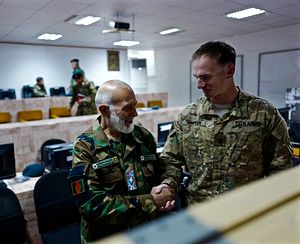It only took the convoy of buff-clad armored trucks a few minutes to reach its destination. Past a two-story empty school building riddled with bullet holes from a complex Taliban attack that killed over 50 in early December, and beyond a now empty bazaar where the worst carnage occurred during the insurgents’ assault, the U.S. military advisors arrive at the Afghan military base after driving less than half a kilometer.
The soldiers are dressed as if for a combat patrol, donning ballistics sunglasses, Kevlar helmets, tactical vests, and carrying assault rifles, side arms and ample ammunition. Even when walking inside the base along a small concrete pathway that leads to the headquarters of the 205th Corps of the Afghan National Army, the U.S. soldiers advance in tactical formation, their rifles at the ready, suspiciously eyeballing every Afghan passing them.
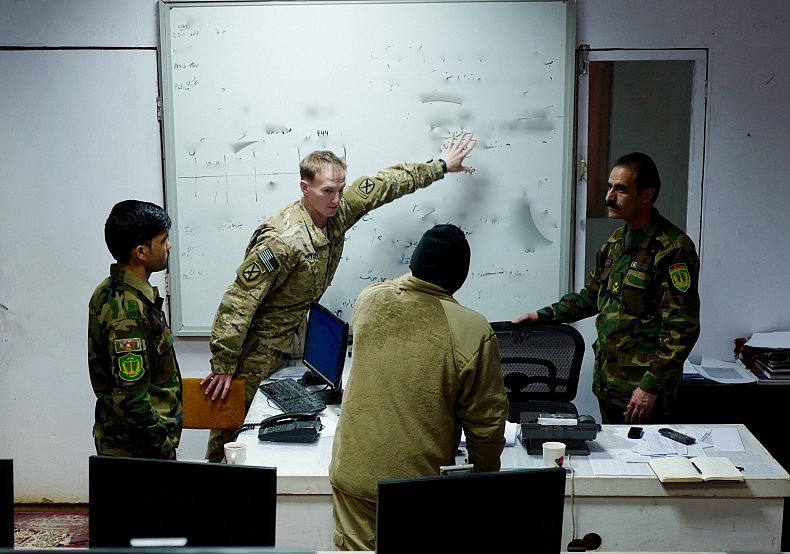
First Lieutenant David Witter and Major Nuzir in the Tactical Operations Center of the 205th Corps. Photo by Franz-Stefan Gady.
With the ever present danger of “green on blue” attacks—Afghan soldiers opening fire on U.S. military personnel—the Americans are not taking any chances, even when shuttling between two bases within a relatively secure defense perimeter. One successful attack could set back their advising efforts for weeks, or even months, and help fuel the flames of those within the American political establishment who increasingly question the rationale behind the United States’ mission in Afghanistan after 14 years of war.
NATO officially declared combat operations in Afghanistan over at the end of 2014 and reduced its troop level to around 13,000 in country. NATO’s combat mission was replaced by a “train, advise, and assist” mission: helping higher ranking Afghan staff officers establish new systems and processes to more efficiently run the military from the top down at the corps level. Only NATO Special Operations Forces are still training their Afghan counterparts at the tactical level.
Inside the headquarters building First Lieutenant David Witter, one of a few dozen NATO advisors based in Kandahar province, takes off his gear and exchanges his rifle for a notebook. A few warm embraces and handshakes with Afghan officers follow. Two U.S. soldiers—“guardian angels” or bodyguards—are discreetly shadowing the young American officer with their weapons ready. (Two guardian angels must accompany any U.S. advisor during their entire time at Afghan military installations.)
“It’s all about relationships. There are some officers you get along with better than others,” Witter explains. He is in the Afghan Corps’ Tactical Operations Center (TOC), a focal point for managing the 205th Corps, whose area of responsibility includes the provinces of Kandahar, Daykundi, Uruzgan and Zabul. “It is, however, with those officers with whom you have a closer personal relationship where you can have the most professional impact.”
On this December morning Lieutenant Witter is waiting for the shift change and for Major Nuzir to take over command of the TOC from another officer. Witter finds Nuzir notably receptive to his advice, which the American officer partially attributes to better interpersonal chemistry between the two. Like the majority of advisors, he has to conduct his business through an interpreter since he is not fluent in Pashto or Dari.
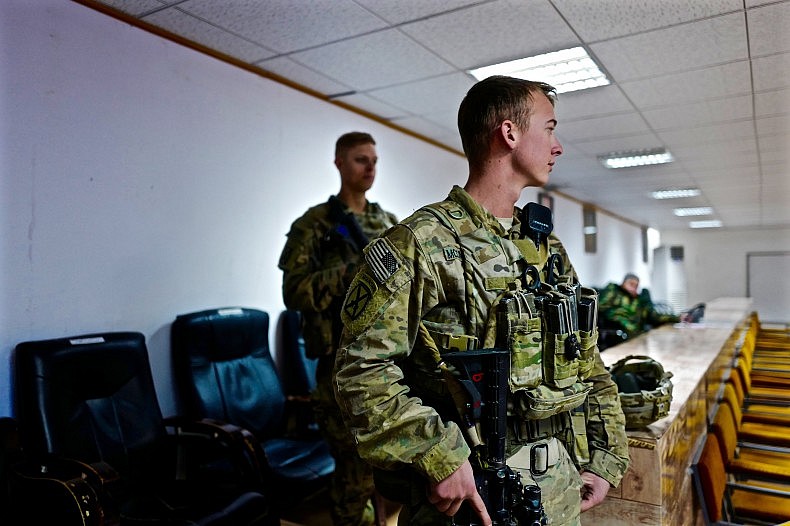
A “Guardian Angel”– U.S. soldiers who act as bodyguards for NATO advisers. Photo by Franz-Stefan Gady.
Witter spends four to five days every week offering advice and support to the Afghan officers in charge of running the TOC. This morning, he begins by discussing a monitoring system with an Afghan officer that would help track the corps’ artillery pieces in order to prevent incidents of friendly fire.
After Major Nuzir arrives, they both review their actions from the previous week during the Taliban attack—but not before a few minutes of small talk asking about their families and health. “How is your family? Were you or your family caught up in the attack?” The American officer observes that simple expressions of care can help ease deeper layers of tension and misunderstanding.
Witter and a few other American advisors were dispatched to the TOC to help with medical evacuations and to keep track of casualties during the fight. The white board in the room still has a casualty chart showing “1630h,” the time it was last updated by Witter on December 8. The Afghans apparently did not follow Witter’s advice to regularly record their own summaries on the board
For a few minutes he once more tries to lay out the benefits of a using the white board versus writing updates on a piece of paper. Like most of his discussions with Afghan officers during that day he prefaces his remarks with “Sorry to take so much of your time. I know you are busy, but may I suggest… ” American advisors are on-the-job consultants, trying to stay in the background while the Afghans are going about their business, waiting for the right moment to offer input—sometimes that moment never arrives.
Before U.S. President Barack Obama’s decision to delay the withdrawal of troops from Afghanistan, the American forces in Kandahar were preparing to leave for good. As a consequence, the advisor team in Kandahar was reduced to a bare minimum, and only recently began to be restored. The team should reach its full strength of about 100 advisors again in the spring of 2016. For now, junior officers have to advise multiple Afghan officers often many years their senior in age and experience. Across Afghanistan, the number of actual military advisors is under 1,000.
While the NATO mission in Afghanistan officially consists of training, assisting and advising, most of the time spent here in Kandahar is focused on advising—a mission “easy to define but difficult to execute” according to one U.S. officer who spoke to The Diplomat—although some Afghan officers still primarily see the Americans as providers. A Colonel, for example, recently asked one of his U.S. counterparts for a new pair of running shoes. Another officer wants the Americans to intervene on his behalf at the Defense Ministry in Kabul since he was stepped over for promotion.
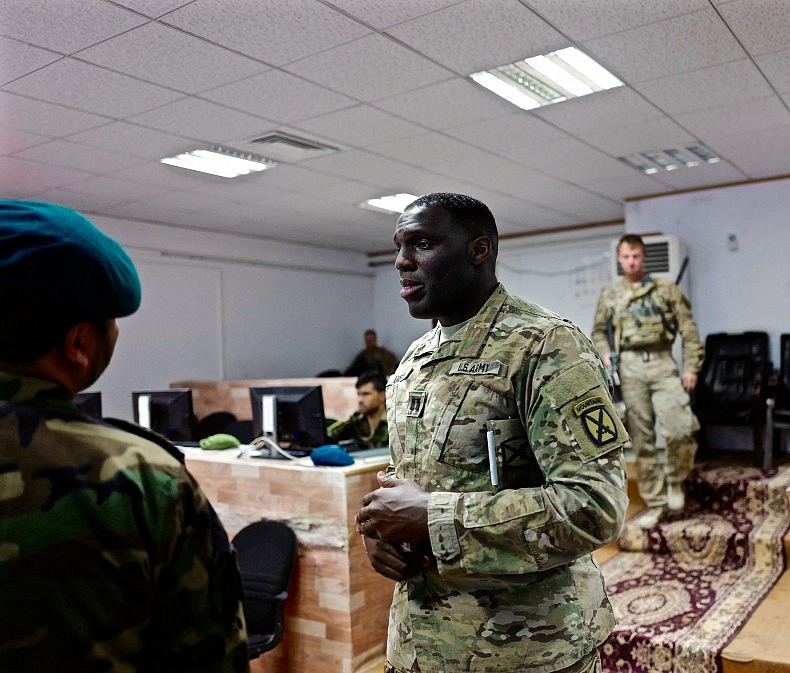
Captain Victor Ugenyi. Photo by Franz-Stefan Gady.
“They are trying to draw out the last measure of a dwindling resource,” according to Captain Victor Ugenyi, another advisor. “But we are trying to help them find it within their own system.” The NATO mission is centered around eight essential functions including planning and budgeting, force generation, sustainment, strategic communications and gender issues, according to a NATO handout. Next to lack of airpower, one of the major deficiencies in the Afghan military remains force sustainment, an area that includes medical services, maintenance, and logistics. “Force sustainment still needs a lot of assistance—no surprises there,” one advisor confides.
In Kandahar, the U.S. military helped the 205th Corps plan its winter campaign and to work “through processes” in the words of one of advisor. According to Captain Marc Burd, the U.S. military also supported Afghan forces in reducing the red tape surrounding the reenlistment of soldiers. “A soldier used to need 46 signatures to reenlist, we helped them reduce it to 14,” Burd states. An Afghan soldier, though, still has to report to his company, battalion, brigade, and corps commanders and have them sign his paperwork, which often requires dangerous travel.
However, several senior officers admit that their job very often consists of just getting Afghan officers to talk to each other “across pillars,” i.e. across units and service branches. In addition, senior advisors often follow up on specific logistical requests (e.g., ammunition, vehicles, spare parts etc.) for Afghan units at the Ministry of Defense in Kabul. (General John F. Campbell, the overall commander of the NATO’s Resolute Support mission, occasionally intervenes on the behalf of certain Army Corps at the Ministry The Diplomat learned.)
It is also part of the advisors’ job to help gather battlefield intelligence given the limited U.S. and NATO footprint in the country. Due to insecure Afghan networks, U.S. advisors have to physically obtain copies of Afghan reports and bring them back to their base where they are then translated. Very often, the advisors learn about smaller military operations conducted by the Afghan military only after the fact.
The physical security of the advisors remains one of the biggest concerns for the military leadership and often inhibits advisors in their job. “We sometimes do not have enough security personnel to push all advisors out, “ Captain Ugenyi explains. (Advisors always travel in a heavily guarded armored convoy to the Afghan base. Once there, one or two bodyguards must accompany them wherever they go.) Sometimes meetings are rushed to limit risks. “This is one of the major limitations of advising,” he notes. Later, when a middle-aged Afghan civilian suddenly appeared unannounced in the TOC, Ugenyi immediately signaled one of the U.S. soldiers to mark him.
U.S. soldiers continuously stress the importance of personal relationships for their work. During the nightly meeting of the entire U.S. team, after everyone returns to base, Colonel Patrick Clark, the senior U.S. advisor, regularly asks the question: “What were the atmospherics while out with the Afghans officers?” Clark was particularly worried about the perception that the U.S. did not do enough to support Afghan security forces during the Kandahar attack, which could negatively impact the U.S. advising effort in the coming weeks.
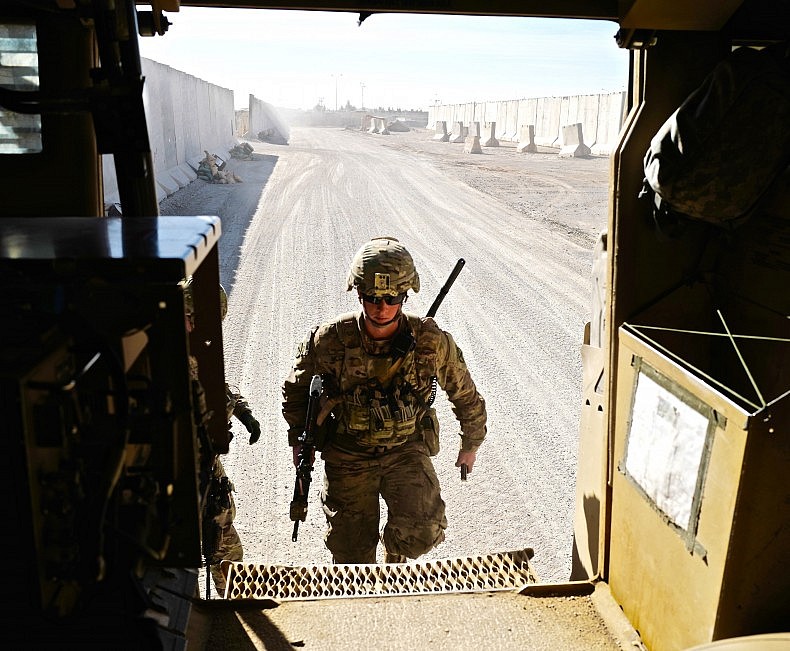
A soldier of the U.S. infantry platoon providing security for the NATO advisors entering a Mine-Resistant Ambush Protected (MRAP) vehicle. Photo by Franz-Stefan Gady.
When it comes to measuring the effectiveness of the U.S. policy hard data is difficult to come by. Indeed, the office of the Special Inspector General for Afghanistan Reconstruction stated in an October 2015 report that the United States does not have a reliable system to rate the capability of the Afghan National Security and Defense Forces.
While the military advisors in Kandahar compile a monthly progress report, many admit that gauging progress objectively is very difficult. “You try to quantify something that is subjective and very difficult to assess,” one advisor told The Diplomat. “Most of the time we are also not seeing immediate effects,” another advisor commented, cautioning against snapshot analyses.
One way to gauge the combat effectiveness is battlefield successes. However, given the nature of conducting a counterinsurgency campaign and the lack of set piece battles, even ascertaining the winner and loser in a fight is often an impossible task.
Consequently, one Colonel emphasized “it is not about winning or losing but about bringing the Afghan National Security and Defense Forces to the threshold of success.” One U.S. Army Captain, however, quoted MacArthur’s old dictum when discussing the conflict in Afghanistan. In war, the general wrote, “there is no substitute for victory.”













